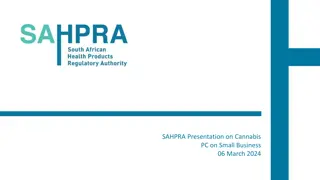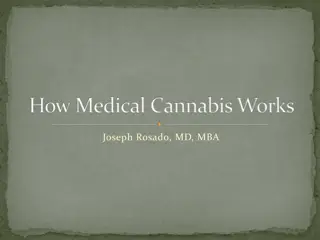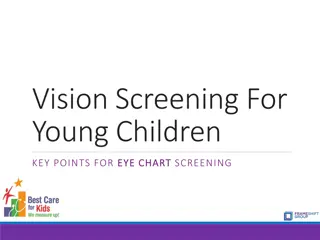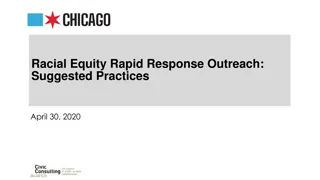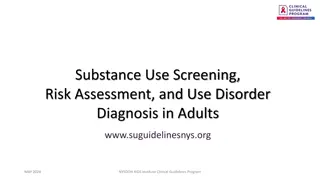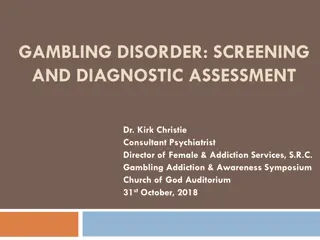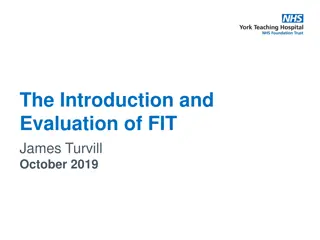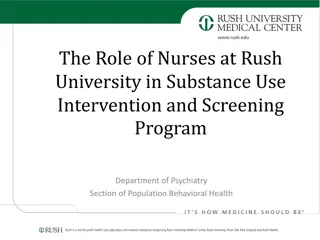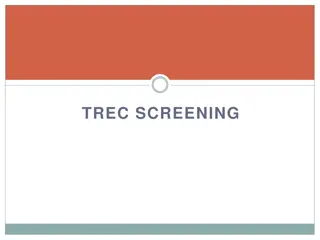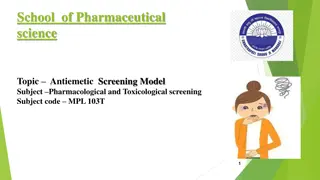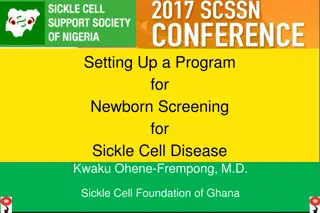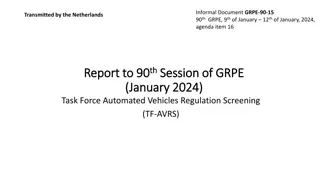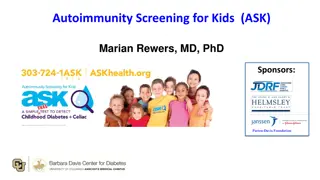Understanding Problematic Cannabis Use: The CAST Screening Test
Cannabis use is prevalent for recreational purposes, but a subset of users may face negative consequences necessitating intervention. The Cannabis Abuse Screening Test (CAST) aims to detect problematic cannabis use in the general population, assisting in early identification and potential clinical intervention. Various challenges and considerations in measuring problematic cannabis use are discussed, emphasizing the need for tailored screening tools like CAST to address this public health concern effectively.
Download Presentation

Please find below an Image/Link to download the presentation.
The content on the website is provided AS IS for your information and personal use only. It may not be sold, licensed, or shared on other websites without obtaining consent from the author. Download presentation by click this link. If you encounter any issues during the download, it is possible that the publisher has removed the file from their server.
E N D
Presentation Transcript
Measuring problematic use in the general population Conception, use and future of the Cannabis abuse screening test (CAST) St phane Legleye CESP, Inserm, Villejuif, France
The rationale for a broader definition of cannabis use than ICD or DSM diagnoses Cannabis use is widespread and mostly used for recreational purpose Only a small proportion of users use cannabis to cope for everyday life difficulties and will ever need a treatment or present clear dependence symptoms Public health interest in defining a problematic cannabis use that relates clearly to negative consequences but that is broader than dependence
Problematic cannabis use? (1) To monitor the cannabis use problem in general population surveys To screen before more in-depth diagnoses in clinical settings Pragmatic definition by the EMCDDA consumption patterns ...leading to negative consequences on a social or health level, both for the individual user and for the larger community (Beck & Legleye, 2008, p. 31)
Problematic cannabis use? (2) Some scholars suggest to simply measure frequency and quantity of use, as is often done in alcohol research (e.g. Newton et al., 2011; Rehm et al., 2013) Such instruments are not specific enough and can lead to a high rate of false positive cases (cf. Asbridge et al., 2014) Though this might be reasonable in clinical contexts, a screening instrument for general population surveys needs to show high specificity Measuring quantity with cannabis is very challenging !
Problematic cannabis use? (3) Structured diagnostic interviews? Too long for general population surveys Threat of high non-response rates Litteracy problems Rare outcomes that are irrelevant for most respondents Focus on current clinical diagnoses that exclude at risk users Broader spectrum of problems and patterns of use Short instruments Validations needed
Short instruments A review by Anna heim and Legleye (2017): ASSIST: 7 items CUDIT: 10 items CPQ-A-S: 12 items CRAFFT: 6 items CUPIT: 16 items DAST-10: 10 items PUM: 8 items SIP-AD: 15 items
CAST: cannabis abuse screening test (1) Designed by Legleye, Beck and Peretti-Watel in 2003 Initially for describing cannabis patterns of use of adolescents during the entire lifespan then restricted to the last 12 months Then assessment of screening properties against gold-standards Five ordered categories for answers (never, rarely, from time to time, fairly often, very often) Score ranging between 0 and 24
CAST: cannabis abuse screening test (2) C1: Have you smoked cannabis before midday? C2: Have you smoked cannabis when you were alone? C3: Have you had memory problems when you smoked cannabis? C4: Have friends or family members told you that you should reduce or stop your cannabis consumption? C5: Have you tried to reduce or stop your cannabis use without succeeding? C6: Have you had problems because of your cannabis use (argument, fight, accident, poor results at school, at work, etc.)?
Validations Internal structure: One or two highly correlated factors F1: C1-C2 ; F2: C3-C6 In adolescents, students and adults in the general population In France, Italy, Hungary, Spain Against POSIT, DSM-IV abuse and dependence, DSM-IV empirical gold-standard via Latent class analysis Against DSM-5 in general population Against ADI-Light in clinical setting
Thresholds DSM-5, assessed with the M-CIDI, 2014 General population survey in France (random, telephone) Age 15-64, n=1351 past-year cannabis users Moderate/severe CUD : 5+ Severe CUD Se=78%, Sp=80% Se=86%, Sp=87% : 7+ Almost identical thresholds in adolescents (France, Italy)
Comparing populations: age invariance Age invariance: (Sznitman, 2016): 18-40 y.o. (18-24, 25-29, 30-40) N=1316, not probabilistic, no weighting, continuous encoding F1: partial invariance: correlations between factor scores are similar across age groups F2: scalar invariance: means of factor score are similar across age groups Age invariance: (Legleye and Rouquette, submitted) N=1351, 15-64 years old, probabilistic, weighted, categorical encoding F1: partial invariance, due to C2 smoking when alone that is more frequent with age F2: scalar invariance
Comparing populations: gender invariance Preliminary analyses suggest no variation in structure and thresholds by gender Complete analysis still has to be conducted
Comparing populations: countries The CAST was an optional module in European school survey project (ESPAD) in 2007, 2011 and 2015. It should be a mandatory module in the next waves Preliminary results through multigroup Principal component analyses and Partical least squares regressions in 13 countries: (Legleye Eslami, Bougeard, 2016) Common PCA structure and country-specific structures are very close BUT complete analysis through confirmatory analysis has to be done
Similarity of ESPAD countries (2011): multigroup PCA Legleye, Eslami, Bougeard, 2016
The CAST and the DSM: multiple factor analysis Communalities and discrepancies between the CAST and the DSM-5 GPS 2014, n=1351, age 15-64, DSM-5 assessed through M-CIDI Multiple factor analysis Aims at estimating and showing the communalities between the instruments Categorical encoding Weighting Relations between partial axes of each instrument CAST and DSM share a first strong dimension The second common dimension is built exclusively by the CAST extreme frequencies of use before midday (C1) and alone (C2), memory problems (C3) and reproaches from friends/family (C4) (Legleye, 2017)
MFA: first factorial plan (partial axes)/ CAST detailed structure
Trends in France (in past-years users) Adolescents aged 17: trend 2008-2014 2008: 18% (regular cannabis use: 7,3%) 2011: 18% (regular cannabis use: 6,5%) 2014: 22% (regular cannabis use: 9,2%) General population (15-64 years old): trend 2010-2014 2010: 21% (past-year cannabis use: 8%) 2014: 21% (past-year cannabis use: 11%)
Synthesis (1) The CAST first dimension is very well correlated with DSM-5 The CAST has a secondary dimension that is almost orthogonal to the DSM-5 It has good psychometric and screening properties High sensitivity and specificity against the DSM-5 Screens for a broader spectrum of patterns of use than the DSM-5 The CAST score is correlated with many psychosocial problems in adolescents (Bastiani et al. 2017) The CAST is not perfect but is the most studied short test screening for problematic use of cannabis
Synthesis (2) Age-invariance is good but not for C2 (smoking alone): clear effect of age on this pattern of use What has to be done: Further study of the extreme responses, optimal rating of the responses Proper assessment of gender-invariance Proper assessment of cross-national invariance in European countries Use in longitudinal studies Predictive power of CAST scores for DSM-5 diagnoses in longitudinal studies Comparisons of assessments and scores at the European level
References (1) Annaheim and Legleye, 2017: Short Instruments to Screen for Problematic Cannabis Use in General Population Surveys. In Handbook of Cannabis and Related Pathologies. Biology, Pharmacology, Diagnosis and Treatment, Academic Press, e168 84. Preedy, Victor R. Asbridge, M., Duff, C., Marsh, D. C., & Erickson, P. G. (2014). Problems with the identification of 'problematic' cannabis use: examining the issues of frequency, quantity, and drug use environment. Eur Addict Res, 20(5), 254-267. Bastiani, L. Potente R., Scalese M. , Siciliano V. , Fortunato L. , Molinaro S., 2017 The Cannabis Abuse Screening Test (CAST) and Its Applications , In Handbook of Cannabis and Related Pathologies. Biology, Pharmacology, Diagnosis and Treatment, Academic Press, 971-980 Beck F, Legleye S. 2008. "Measuring cannabis related problems and dependence at the population level" in A Cannabis reader: Global issues and local experiences, p 29-57 (Vol. 2) Lisbon, EMCDDA. Legleye, S., D. Piontek, and L. Kraus. 2011. Psychometric Properties of the Cannabis Abuse Screening Test (CAST) in a French Sample of Adolescents. Drug Alcohol Depend 113 (2 3): 229 35. Legleye, S., Kraus L., Piontek D., Phan, O., Jouanne C. 2012, Validation of the Cannabis abuse screening test in a sample of inpatients, European addiction research, 18:193-200 Legleye, S., D. Piontek, L. Kraus, E. Morand, and B. Falissard. 2013. A Validation of the Cannabis Abuse Screening Test (CAST) Using a Latent Class Analysis of the DSM-IV among Adolescents. Int J Methods Psychiatr Res 22 (1): 16 26. Legleye, S., R. Guignard, J.B. Richard, K. Ludwig, A. Pabst, and F. Beck. 2015. Properties of the Cannabis Abuse Screening Test (CAST) in the General Population. Int J Methods Psychiatr Res 24 (2): 170 83.
References (2) Legleye, S., Eslami A., Bougeard S. 2016, Assessing the structure of the CAST (Cannabis Abuse Screening Test) in 13 European countries using multigroup analyses, Int J Methods Psychiatr Res 26(1) Legleye, S, 2017, The Cannabis abuse screening test and the DSM-5 in the general population: optimal thresholds and underlying common structure using multiple factor analysis, Int J Methods Psychiatr Res (to be published) Newton, A. S., Gokiert, R., Mabood, N., Ata, N., Dong, K., Ali, S., Vandermeer, B., Tjosvold, L., Hartling, L., & Wild, T. C. (2011). Instruments to detect alcohol and other drug misuse in the emergency department: a systematic review. Pediatrics, 128(1), e180-192. Rehm, J., Marmet, S., Anderson, P., Gual, A., Kraus, L., Nutt, D. J., Room, R., Samokhvalov, A. V., Scafato, E., Trapencieris, M., Wiers, R. W., & Gmel, G. (2013). Defining substance use disorders: do we really need more than heavy use? Alcohol Alcohol, 48(6), 633-640. Piontek, D., L. Kraus, and D. Klempova. 2008. Short Scales to Assess Cannabis-Related Problems: A Review of Psychometric Properties. Subst Abuse Treat Prev Policy 3: 25. Piontek, D., L. Kraus, S. Legleye, and G. Buhringer. 2011. The Validity of DSM-IV Cannabis Abuse and Dependence Criteria in Adolescents and the Value of Additional Cannabis Use Indicators. Addiction 106 (6): 1137 45. Sznitman, R dner S. 2016. The Cannabis Abuse Screening Test (CAST) Revisited: Examining Measurement Invariance by Age. Int J Methods Psychiatr Res, October. doi:10.1002/mpr.1529.









